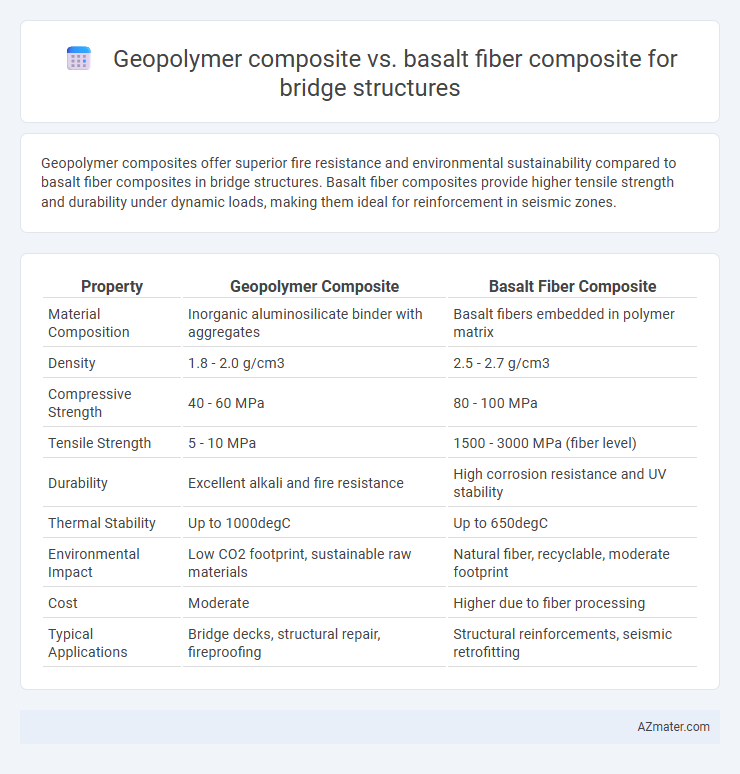Geopolymer composites offer superior fire resistance and environmental sustainability compared to basalt fiber composites in bridge structures. Basalt fiber composites provide higher tensile strength and durability under dynamic loads, making them ideal for reinforcement in seismic zones.
Table of Comparison
| Property | Geopolymer Composite | Basalt Fiber Composite |
|---|---|---|
| Material Composition | Inorganic aluminosilicate binder with aggregates | Basalt fibers embedded in polymer matrix |
| Density | 1.8 - 2.0 g/cm3 | 2.5 - 2.7 g/cm3 |
| Compressive Strength | 40 - 60 MPa | 80 - 100 MPa |
| Tensile Strength | 5 - 10 MPa | 1500 - 3000 MPa (fiber level) |
| Durability | Excellent alkali and fire resistance | High corrosion resistance and UV stability |
| Thermal Stability | Up to 1000degC | Up to 650degC |
| Environmental Impact | Low CO2 footprint, sustainable raw materials | Natural fiber, recyclable, moderate footprint |
| Cost | Moderate | Higher due to fiber processing |
| Typical Applications | Bridge decks, structural repair, fireproofing | Structural reinforcements, seismic retrofitting |
Introduction to Composite Materials in Bridge Construction
Geopolymer composites offer superior chemical resistance and thermal stability compared to basalt fiber composites in bridge construction, enhancing durability under harsh environmental conditions. Basalt fiber composites provide high tensile strength and excellent fatigue resistance, making them suitable for load-bearing components in bridges. Both materials contribute to lightweight structures with improved lifespan and reduced maintenance requirements in modern infrastructure projects.
Overview of Geopolymer Composites
Geopolymer composites are advanced construction materials formed by combining aluminosilicate-rich precursors with alkaline activators, resulting in high thermal stability, excellent chemical resistance, and superior mechanical properties compared to traditional cement-based materials. These composites exhibit low carbon footprints, enhanced durability, and excellent fire resistance, making them ideal for sustainable bridge structures. Their compatibility with various fibers, including basalt fibers, allows tailoring composite strength and toughness for optimized structural performance.
Understanding Basalt Fiber Composites
Basalt fiber composites exhibit exceptional tensile strength, chemical resistance, and thermal stability, making them highly suitable for bridge structure applications where durability and load-bearing capacity are critical. Their inherent corrosion resistance offers a significant advantage over traditional materials, reducing maintenance costs and extending the lifespan of bridges exposed to harsh environmental conditions. Compared to geopolymer composites, basalt fiber composites deliver superior flexibility and impact resistance, essential qualities for dynamic stress absorption and structural integrity in bridge engineering.
Mechanical Properties Comparison
Geopolymer composites exhibit superior fire resistance and chemical durability compared to basalt fiber composites, making them ideal for harsh bridge environments. Basalt fiber composites provide higher tensile strength and better impact resistance, enhancing structural load-bearing capacity and flexibility. The balance between geopolymer's compressive strength and basalt fiber's tensile properties is crucial for optimizing bridge durability and performance.
Durability and Environmental Resistance
Geopolymer composites exhibit superior durability and environmental resistance compared to basalt fiber composites in bridge structures, with enhanced alkalinity and resistance to chemical attacks, including sulfate and chloride ions. Basalt fiber composites, while possessing good tensile strength and corrosion resistance, demonstrate lower performance in highly alkaline and marine environments, limiting their lifespan under aggressive conditions. The superior thermal stability and resistance to freeze-thaw cycles of geopolymer composites make them more suitable for long-term structural applications in harsh outdoor environments.
Sustainability and Eco-Friendliness
Geopolymer composites offer superior sustainability for bridge structures due to their reduced carbon footprint and utilization of industrial byproducts like fly ash and slag, significantly lowering greenhouse gas emissions compared to traditional materials. Basalt fiber composites are also eco-friendly, derived from abundant natural volcanic rock, providing high durability and corrosion resistance that extends bridge lifespan and reduces maintenance frequency. Choosing geopolymer composites combined with basalt fibers enhances eco-efficiency, promoting long-term structural resilience while minimizing environmental impact.
Cost Analysis and Resource Availability
Geopolymer composites offer a cost-effective alternative to basalt fiber composites for bridge structures due to lower raw material expenses and reduced energy consumption during production. Basalt fiber composites can incur higher costs because of expensive fiber extraction processes and limited availability of high-quality basalt rock deposits. Resource availability favors geopolymer composites since industrial by-products like fly ash and slag are abundant, while basalt fiber sourcing depends on geographically constrained basalt reserves.
Structural Performance in Bridges
Geopolymer composites exhibit superior resistance to corrosion and high compressive strength, enhancing the durability and longevity of bridge structures. Basalt fiber composites offer excellent tensile strength and impact resistance, making them ideal for supporting dynamic loads and seismic activities in bridges. Combining geopolymer matrices with basalt fiber reinforcements results in a composite material with optimized structural performance, including improved load-bearing capacity and reduced maintenance costs for bridge infrastructure.
Application Case Studies and Real-world Examples
Geopolymer composites demonstrate superior durability and fire resistance in bridge structures, as evidenced by the Kurunegala Bridge in Sri Lanka where enhanced chemical stability reduced maintenance costs significantly. Basalt fiber composites offer excellent tensile strength and corrosion resistance, exemplified by the Larissa Bridge in Greece, which benefits from reduced weight and extended lifespan compared to traditional materials. Case studies reveal geopolymer composites excel in aggressive environmental conditions, while basalt fiber composites optimize structural performance under high load and seismic activity.
Future Prospects and Innovations in Bridge Engineering
Geopolymer composites offer superior fire resistance, reduced carbon footprint, and enhanced durability compared to traditional basalt fiber composites, making them a promising material for sustainable bridge structures. Innovations in nano-modification and fiber hybridization aim to improve the mechanical properties and longevity of geopolymer composites under harsh environmental conditions. Future prospects emphasize integrating smart sensor technologies within geopolymer matrices to enable real-time structural health monitoring and adaptive load management in advanced bridge engineering.

Infographic: Geopolymer composite vs Basalt fiber composite for Bridge structure
 azmater.com
azmater.com